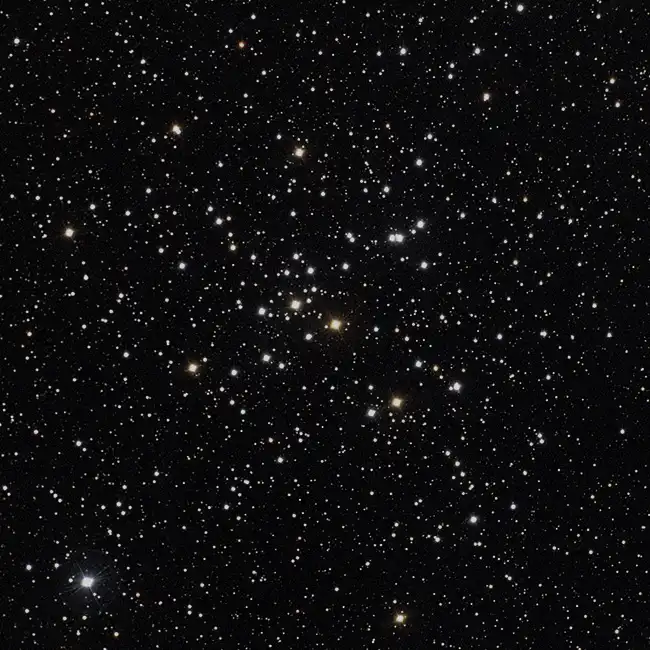Messier 41 (M41) is an open star cluster located in the constellation Canis Major. It lies at a distance of about 2,300 light-years from Earth and has an apparent diameter of around 25 light-years. M41 contains approximately 100 stars, including several red giants, the brightest of which shines at a magnitude of 6.9. This cluster is estimated to be around 190 million years old, making it relatively young in astronomical terms.
M41 is a stunning cluster that is often overshadowed by its neighboring star, Sirius, the brightest star in the night sky. However, for those who take the time to explore this celestial gem, M41 offers a rich field of stars, with many of them forming a distinct pattern that is sometimes likened to a loose “Christmas tree” shape.
Magnitude
M41 has an apparent visual magnitude of 4.5, making it visible to the naked eye under dark skies, though it is best observed with binoculars or a small telescope. With its relatively low magnitude, it appears as a faint smudge to the unaided eye but reveals its true beauty through optical aid, where the individual stars within the cluster can be distinguished.

Prominent Season
M41 is best observed during the winter months in the Northern Hemisphere, with its prominence peaking in the evening sky from December to March. This makes it an excellent target for winter stargazing, especially when the night skies are crisp and clear.
Constellation
M41 is located in the constellation Canis Major, which is Latin for "Greater Dog." Canis Major is home to Sirius, the brightest star in the night sky, which serves as an excellent guidepost for locating M41. The constellation is associated with the mythological hunting dog of Orion the Hunter and is one of the most recognizable constellations in the winter sky.
How to Find M41
Finding M41 is relatively straightforward, especially if you are already familiar with locating Sirius. To find M41:
- Locate Sirius: Start by finding Sirius, which is the brightest star in the sky and is part of the constellation Canis Major. It is hard to miss and is visible even in light-polluted areas.
- Move South: Once you have Sirius in your sights, move your telescope or binoculars about four degrees south (about the width of two fingers held at arm's length) from Sirius.
- Identify the Cluster: At this position, you should spot M41 as a distinct cluster of stars. In binoculars, M41 will appear as a fuzzy patch, but through a telescope, it will resolve into individual stars, with the brighter red giants standing out prominently.

History
The history of M41 is quite fascinating. Although it was likely observed by ancient astronomers, the first recorded observation of M41 dates back to 1654 when the Italian astronomer Giovanni Battista Hodierna included it in his catalog of nebulae. However, it wasn't until 1702 that the famous English astronomer John Flamsteed independently noted the cluster.
M41 was later observed by Charles Messier, who added it to his now-famous catalog of "nebulae and star clusters" in 1765. Messier was an avid comet hunter, and he created his catalog to help other astronomers avoid mistaking these permanent celestial objects for comets.
M41 has since become a popular target for amateur astronomers due to its relative brightness and easy location in the sky. Its proximity to Sirius and its striking arrangement of stars have made it a subject of interest and study over the centuries.
Conclusion
Messier 41 is a beautiful and accessible open star cluster that offers a rewarding experience for amateur astronomers. Whether you're using binoculars or a telescope, M41’s collection of stars is a sight to behold, especially when viewed under the clear winter skies. Its historical significance, coupled with its straightforward location near Sirius, makes it a must-see object for anyone interested in exploring the wonders of the night sky.
